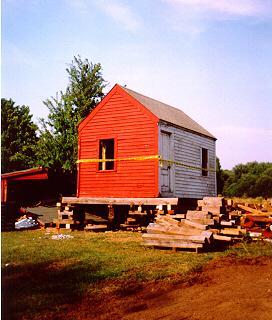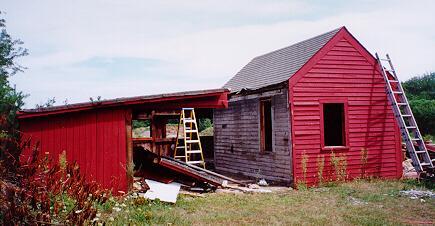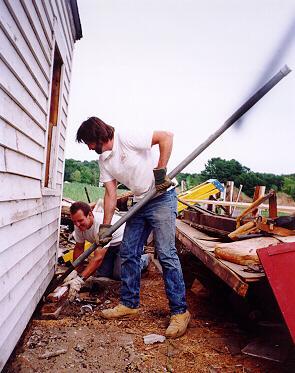Adapted and updated from an article by M.I. MacDonald
Atlantic News , September 2, 1999
HAMPTON — In a concerted effort involving Hampton’s Heritage Commission, the town’s Historical Society, the department of public works, and local citizens and businessmen, one of Hampton’s remaining classic structures has found a new home. The Blake cooper shop, which for many decades made its home on the rolling grounds of Wayside Farm (the former Holman family homestead), was relocated for the second time in its existence.
The circa 1820 cooper shop was moved to its new location on Friday, September 3, in a group effort that brought real estate developers and historic preservationists together in a unique, though temporary, partnership. The cooperage was moved from its current location on a subdivision of Wayside Farm owned by local developer Green & Company, to its new resting place by the old blacksmith shop, also a Heritage Commission/Historical Society project from several years ago. This concentrates a charming chunk of Hampton history in a small area, as the cooperage now sits directly behind Hampton’s Victory Garden.
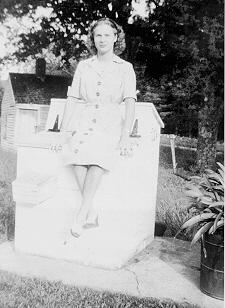
The Cooper Shop at 62 Little River
Road, with Joanne Blake, daughter
of Winnie & Mae Blake,
sitting on well-head in 1944.
[Photo courtesy Stanwood Brown]
The move was the culmination of a project which, by necessity, had to come together quickly in its final stage, despite the fact that uncertainty dogged the project over the summer as the fate of the cooperage hung undecided. Fortunately, Hampton’s Conservation Commission was able to give the go-ahead for relocation of the structure to town-owned land (“Viviane Marcotte has helped us, of course, all the way.” comments Ansell Palmer) under the Commission’s direct jurisdiction.
Along with the donation of equipment and labor by the town, the DPW, and former Hampton town selectman Michael Plouffe, as well as the negotiating and planning efforts of several individuals involved with the project, the salvation of the shop was sealed in a surprise move on the part of Green and Company Building and Development.
In generous cooperation with the efforts to salvage and relocate the shop, Michael and Richard Green of Green and Company agreed to donate the shop to the town and cooperate with the preparations for its move from their property, provided the relocation of the shop be made so that Green and Company could continue their development project on the former grounds of Wayside Farm. Green and Company also paid the cost of the moving and setup, in conjunction with some donated labor.
“It’s nice that it’s going to be done. We didn’t know for a while. Green and Company needed it out of the way one way or the other, so it’s good that action could be taken to save it,” said Palmer with evident satisfaction, as the successful end to the project got to be in sight.
Preparations for the move were quick and efficient. The building was first placed on blocks, while it awaited clearance from the various and multiple utility companies, before the moving route could be confirmed and traversed.
“We’re pretty much ready,” agreed Ansell Palmer before the move, affiliated with both the Historical Society and the Heritage Commission, and a key figure in linking the diverse individuals and commissions now involved in the project. “Bob Pothier (of the First Period Colonial in Kingston, New Hampshire) and his assistant (John Auger) spent about a day preparing it. And, the DPW has gone to clear the area where it’s going to sit. It’s ready to go.”
The project quickly became a joint effort from the beginning, says Palmer.
“It came about that John Holman contacted me, then I contacted the president of the Heritage Commission — Steve McGuinness — and it was discussed at a Heritage Commission meeting late last spring, then things just evolved from there.”
The organizers had originally anticipated a great need for volunteers to do the clearing of the land, “but the town of Hampton and the DPW has taken care of that,” said Palmer, with former Selectman Michael Plouffe bringing his equipment, manpower and expertise — not to mention his truck — on moving day to load up and negotiate the roughly 3/4 mile route the house took to its new site. So, with cooperation and initiative, the foundation of the Seacoast’s historic heritage is being rebuilt — one step at a time.
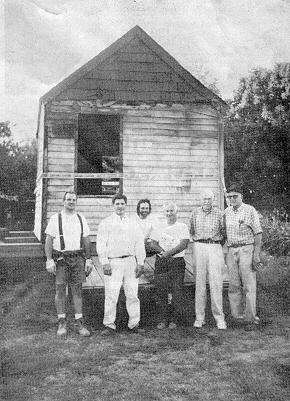
LOADED UP AND READY TO GO.
The folks involved in the relocation of the Blake cooper shop are shown here with the structure after it was loaded onto a trailer prior to being transported to its new site on Barbour Road. Standing left to right are John Auger of First Period Colonial Restoration, Michael Green of Green and Company, Bob Pothier of First Period Colonial, Michael Plouff, Ansell Palmer, and John Holman.
[Atlantic News Photo by Liz Premo]

MOVING DAY
On the back of a trailer supplied by former Hampton Selectman Michael Plouffe, the Blake cooper shop, complete with a police escort, sits ready to begin its trek to another part of town.
[Atlantic News Photo by Liz Premo]
By M. I. MacDonald with John M. Holman, Hampton History Volunteer
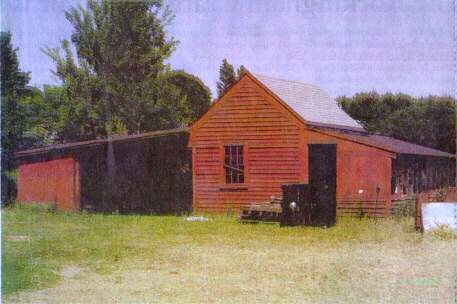
HAMPTON – Once again, economic progress and historic preservation clash, with the result that the fate of another historic Hampton structure is in jeopardy.
As Seacoast towns grow and prosper, the demand for space becomes more urgent, and the larger tracts of land that are the region’s legacy from centuries of family farms and estates, are inevitably sliced off into smaller parcels of residential and commercial real estate on which new generations stake their claim.
The landscape of New Hampshire retains somewhat its appearance of a classic quilt, as in yesteryear rolling hills, meadows and woodlands formed the squares and seams of the Granite State’s heritage quilt, but now that quilt is composed of property lines and pavement, segmenting the landscape.
Still, scattered throughout the state are historic structures that have survived the test of time, often through the dedication of townspeople who “remember when,” and historical societies – both local and national – who work together to find a new niche for the homes that history has built, and that have been a part of building history.
The Blake cooper shop may be one such place, if some of Hampton’s most concerned citizens succeed in their petitions for preservation.
The Blake Cooper shop was originally located at 62 Little River Road, the former home of Winthrop & Mae Blake. Winthrop was a painter by trade, whose life crossed the bridge between the 19th and 20th centuries; born in 1886, he died in 1960 at the age of 74. Before Winthrop, his father, Amos Knight Blake (1851-1944), was also a painter and lived on the homestead. Amos had married Martina L. Fairbanks, daughter of Rufus S. Johnson, on June 31, 1880.
Even farther back, Amos’ father, Dearborn Blake, was a cooper (one who makes barrels); this is where the Blake cooper shop got its name. Dearborn, too, was a painter. He was the son of Jonathan Blake and his wife Mary Ann Godfrey (daughter of Nathan Godfrey).
The cooper shop, a landmark for generations, is no stranger to moving. Many years ago, probably during the 1940s or early-50s, Marshall Holman, a vegetable farmer for more than 40 years since the early 1920s, obtained the cooper shop from Winnie Blake, and had it moved from Little River Road to “Wayside Farm,” located at 263 Mill Road, to be used as a vegetable seed storeroom.
Although a shop and greenhouse were attached to it over the years, it, essentially remained structurally unchanged over these many decades. Now that Green & Company has purchased the land surrounding the homestead known fondly as “Wayside Farm” on Mill Road, the area is slated to be the site of a sub-division of 11 homes.
It seems it’s time for a new home to be chosen for the c.1820 cooper shop, so that Hampton’s heritage will not lose another irreplaceable gem. It has been suggested that an ideal spot for the cooper shop’s relocation would be on Barbour Road (originally Black Swamp Road), next to the Barbour blacksmith shop. Supporters of the plan to preserve the shop and the memories (and centuries) it represents hope the arrangement will take place, in order to preserve a little more of Hampton history, that it not succumb to the “proverbial wrecking ball.”
The uncertain future of the cooper shop hangs in the balance, but the townspeople of Hampton can retain this historic building that has done its work steadfastly for more than 175 years. Concerned citizens who wish to participate in the process of finding a new home for the Blake cooper shop, or who wish to make their voices heard on the topic and perhaps voice their support of preserving the building, may wish to contact Arthur Caira of the Hampton Historical Society at 926-5969, or Steve McGinnis of the Hampton Heritage Commission at 926-0505, for further information on this and other classic structures in the area, and also for guidance on historic preservation efforts in Hampton.
